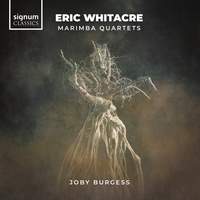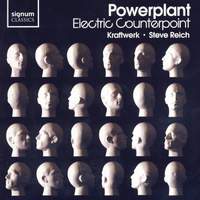Interview,
Joby Burgess on A Percussionist's Songbook
 The music of percussionist Joby Burgess last crossed my path a few years ago when he featured as the soloist in Gabriel Prokofiev's Bass Drum Concerto. The life of a percussionist, though, is one of constant instrumental variety, and Joby's toolkit naturally contains far more than just a selection of bass drum mallets - as his lockdown project, the Virtual Marimba Choir, shows.
The music of percussionist Joby Burgess last crossed my path a few years ago when he featured as the soloist in Gabriel Prokofiev's Bass Drum Concerto. The life of a percussionist, though, is one of constant instrumental variety, and Joby's toolkit naturally contains far more than just a selection of bass drum mallets - as his lockdown project, the Virtual Marimba Choir, shows.
Just out at the end of September is a new and very personal project of commissions from and for Joby, which he performs with the aid of a wealth of electronic techniques and equipment. With inspirations ranging from classic sci-fi novels to United Nations figures on human population growth, A Percussionist's Songbook shows the enormous capabilities of contemporary writing for pitched percussion.
I caught up with Joby to talk about how this album came together and what makes it so special to him.
Where did the idea first come from to assemble this ‘songbook’?
The idea of a songbook was really harking back to my first love, when I started buying music, which was seven-inch singles in the middle of the 1980s. It wasn't the first music I listened to, but it was the first music I went out and spent my hard-earned pocket money on. I still have a real fondness for, and attraction to, that era of music and that short form of music.
The Songbook is also a reflection on some of the journeys that I've made - the composers I've commissioned for this project are people that I have really quite personal links with. Graham Fitkin’s Hook I bought from a record shop in Bath in the early '90s and made me want to play the marimba rather than being a rock'n'roll drummer. Gabriel Prokofiev and I have worked together for years and years on numerous commissions and project; I've played percussion on numerous of John Metcalfe and Dario Marianelli's album project and film scores respectively. So there are very strong connections between myself and all of the composers I've asked to write for this project.
They are all brand-new commissions, which haven't seen the light of day apart from a brief video premiere for the Cambridge Music Festival last year. That was something that I really wanted to do; often, in the world that I've inhabited, the process of commissioning a work takes a long time, and then you go out and you tour it and then you go and record it sometime years later. So taking a leaf out of the pop industry's book, I really wanted to make a commissioning project which would be released as it was first toured – and the first day of the Songbook tour is the album's release-day. I'm really excited about that. And now I've done it once, it makes it much easier to do that in the future.
Is that compressed, relatively short-form expression you mention something that you’re seeking to achieve on this album too?
I suppose so, yes - I like that bite-sized, focused feeling. Another composer friend Howard Skempton - known particularly for his miniatures - has always talked to me about this fantastic compositional process he has, where he gets an awful lot of ideas and then slowly hones them down. As if you took a glass of squash and somehow took out all the water until you had only the concentrated stuff, and that would be the piece.
This is a dizzyingly varied album, with influences coming from ancient West Asian folk-tales, Isaac Asimov’s vision of the future, and contemporary institutions and individuals sounding warnings about the trajectory of the planet. What would you say the unifying thread is that binds these disparate works together?
The main thing that binds it together is actually the selection of instruments - that very unified set of melodic percussion instruments which I've chosen. To set that very small palette of instruments, and also to stage them (they're laid out in quite a particular way so an audience can see right the mallets connect with each instrument) was something for the composers to work within. Another interest that's been with me all the years I've been working is in electronics, each composer is bringing some kind of electronic component to the collection.
I asked everyone to choose a story or words that meant something to them, on which they could reflect - which was really to give the listener another way in - this idea of narrative. Whether it's just a few lines from a poem or a larger concept.
So it's fairly personal not just for you, but also for the contributing composers?
I think so. Every composer has a different take on it. For example, in John Metcalfe's piece Love without hope he immediately came up with this little piece of poetry by Robert Graves, just four lines long. And he had this lovely idea about how that could be represented in music, in terms of the hat coming off and the birds coming out, and illustrating that using all these very specific delays on the synth that I'm playing - to create this kind of flock-of-birds effect. Each composer took something that was personal to them; Graham more recently, has explored political themes to some of his works, and the idea of population growth made a great thread for his commission ‘Species’.
So it was really interesting to hear all those stories - it made me go out a few different books as well, which is never a bad thing!
The nice thing is, too, that it therefore gives the listener, who may not be au fait with percussion music, something to latch on to: a little story by Birago Diop, for example, about what our ancestors mean to us. It's a whole different way into a piece of music, and for me that process and that sense of focus and of journey is quite useful as a listener.
While you’re clearly as much of a multi-instrumentalist as any percussionist, you seem to have a particular fondness for the marimba – you released an album of Whitacre transcriptions for marimba quartet in early 2020, followed by a ‘virtual choir’ of tuned percussion in the early months of the COVID-19 pandemic. And now here you are with a marimba-centric album of new commissions – what is it about this instrument that so attracts you?
It's interesting - I grew up as a rock'n'roll and jazz drummer, as a child and as a teenager, and I would always describe myself as a late starter of a percussionist. I was about sixteen or so. Of all the tuned mallet instruments, the marimba is great because it's got range, and it's got low notes. The one thing we suffer with in percussion music is actually having real low notes. The marimba that I'm using on this album goes down to low ‘cello’ C - and the wonderful thing about using that instrument in terms of melody is that that's where all the bass notes can go. It's almost like the cello within a string quartet, or the bass in a rock band. It fulfils that role.
Although the marimba is reasonably present on this album - it coexists with the vibraphone as the workhorses of the instrumental family used here - I actually hadn't played a large amount of marimba for a long time, at least not as a frontline instrument. It was only my recent work with Eric Whitacre that led me to fall back in love with it – after Eric’s initial suggestion, I had to spend quite a lot of time thinking about how to make his music sing through a bunch of wooden bars.
Having played a lot of electronic instruments and found objects, and a lot of vibraphone in fact - that's probably the most flexible of all the mallet instruments - it was nice to come back to it. We do have that kind of journey in and out of instruments, as percussionists - you don't play one for a while and then you find yourself suddenly playing it a lot. But the melodic instruments I've chosen for this project are built around the core, with a collection of other wonderful instruments that extend the ranges and the timbres and the colours from there.
Joby Burgess's Virtual Marbima Choir performs an arrangement of Eric Whitacre's Sleep
Many of the works on this album include extensive electronic elements – samples, distortions and more. Are there works here that (like some of those pop songs, perhaps) simply can’t be reproduced on the live stage and can only exist on recordings?
No - they're definitely going to exist live! It's designed for me to be able to reproduce live. One of the things that I've been doing for a long time, going back to the first album I made for Signum, a project called Powerplant where we reworked the music of Steve Reich and Kraftwerk side by side, is to use live looping to enable one performer to play more than one line, and using digital delays to create rhythmic effects, building textures by overlaying lines in often quite complicated ways. That's how these pieces were conceived, although certainly through composed and those elements of looping or rhythmic delay is built into their composition.
So you don't need an ensemble at all?
No - it's a solo album and it will be performed solo. The multi-tracking creates the impression of some of them being ensemble pieces, and that's something that I've always done, going back many many years. The early examples of that would be things like Pat Metheny playing Steve Reich's Electric Counterpoint - where you are just re-creating performances of yourself all the time. Of course these days we're able to do those things live - it's a different thing to playing in an ensemble. I don't think one is better or worse, they are simply different approaches.
It's very interesting when you have just one person recording and playing on top of themselves - sonically it's really quite a different experience. And it's something I've always enjoyed, and a lot of the solo artists that I've followed have used those bits of digital kit to enhance their playing.
Joby Burgess (percussion)
Available Formats: CD, MP3, FLAC
Rob Farrer, Calum Huggan, Sam Wilson, Joby Burgess (marimbas)
Available Formats: CD, MP3, FLAC, Hi-Res FLAC
Powerplant
Available Formats: CD, MP3, FLAC
Pat Metheny (guitar), Kronos Quartet
Available Formats: MP3, FLAC






